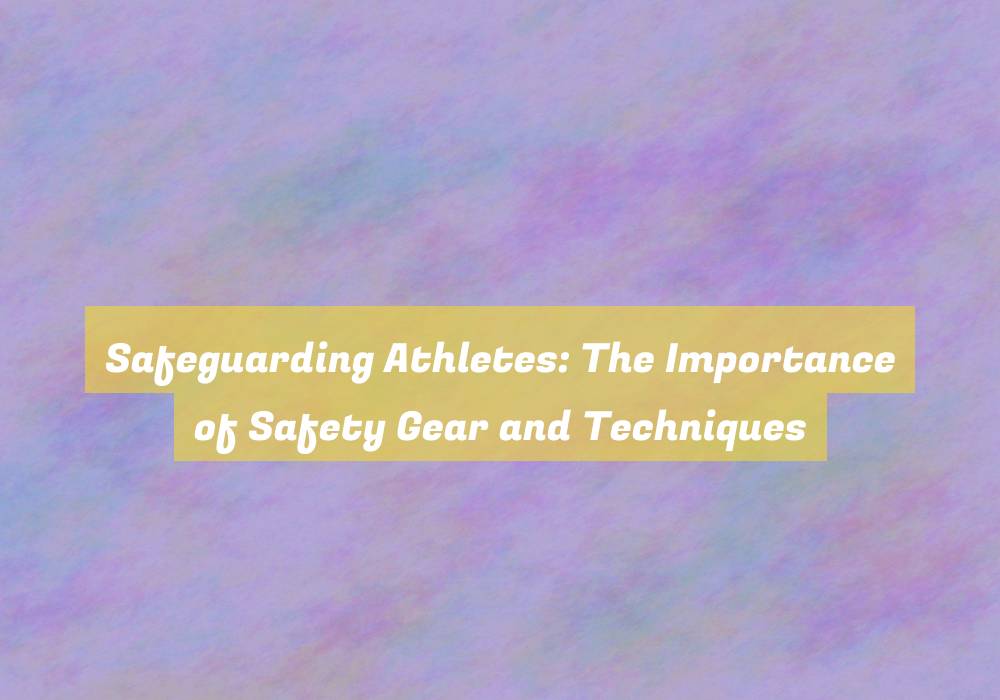Safeguarding Athletes: The Importance of Safety Gear and Techniques
YouG??ve probably witnessed how thrilling it is to watch athletes perform at their peak, but have you ever considered the meticulous precautions that go into ensuring their safety?
Safeguarding athletes goes beyond just wearing protective gear; it involves a combination of proper training, technique, and implementing safety measures.
The discussion around the importance of safety gear and techniques in the world of sports is not only relevant but also crucial for athletes to perform at their best while minimizing the risk of injury.
Importance of Protective Gear
You must prioritize the use of protective gear to ensure your safety during athletic activities. Whether youG??re hitting the basketball court, cycling through rugged terrain, or stepping onto the football field, the right gear can make all the difference.
Helmets, pads, gloves, and other protective equipment serve as your first line of defense against potential injuries. They act as a shield, absorbing impact and reducing the risk of serious harm. Without this crucial gear, you leave yourself vulnerable to concussions, fractures, and other severe injuries that could sideline you for weeks or even months.
ItG??s not just about following the rules or regulations; itG??s about safeguarding your well-being and longevity in your chosen sport. By investing in high-quality protective gear and ensuring it fits properly, you actively minimize the chances of getting hurt.
Training for Injury Prevention
To prevent injuries during athletic activities, itG??s essential to incorporate training routines focused on injury prevention.
One key aspect of injury prevention training is to ensure that athletes have a strong and stable foundation. This involves exercises that target core strength, balance, and flexibility. By strengthening the core muscles, athletes can improve their overall stability and reduce the risk of sustaining injuries during physical activities. Additionally, incorporating exercises that enhance balance and flexibility can help athletes move more efficiently and with better control, further reducing the likelihood of injuries.
Furthermore, training for injury prevention should also involve specific drills and techniques that mimic the movements involved in the particular sport. For instance, athletes can benefit from practicing proper landing and cutting techniques to minimize the risk of ankle and knee injuries. By training the body to move in a biomechanically sound manner, athletes can better protect themselves from common sports-related injuries.
Incorporating injury prevention training into regular workout routines can significantly reduce the risk of injuries and allow athletes to perform at their best while staying safe.
Role of Proper Technique
Proper technique plays a crucial role in building upon the foundation of injury prevention training. It enables athletes to execute movements in a biomechanically sound manner, reducing the risk of common sports-related injuries.
When you perform activities with the correct technique, you distribute the workload evenly across the muscles and joints involved. This minimizes the strain on any particular area and helps to prevent overuse injuries. It also reduces the likelihood of acute injuries caused by sudden, uncontrolled movements.
Additionally, using proper technique can enhance your overall athletic performance. It maximizes the efficiency of your movements and reduces wasted energy. By maintaining good form, you also support the natural alignment of your body, which contributes to better balance, coordination, and stability.
ItG??s important to remember that mastering proper technique takes time and practice. However, the benefits in terms of injury prevention and performance improvement make it well worth the effort. Therefore, prioritize learning and implementing correct techniques in your training and competition to safeguard yourself against unnecessary injuries.
Implementing Safety Measures
Athletes can enhance their safety by implementing appropriate safety measures, including the use of protective gear and adherence to established safety protocols during training and competition.
When it comes to protective gear, ensure that you have the right equipment for your sport. This may include helmets, padding, mouthguards, or eyewear. Always inspect your gear for any signs of damage and replace it as needed to maintain its effectiveness. Additionally, make it a habit to wear your protective gear consistently, regardless of the intensity of the activity or the level of competition.
In addition to gear, itG??s crucial to adhere to established safety protocols. This means following the rules of your sport, as well as any guidelines for safe training and competition. Take the time to familiarize yourself with the specific safety regulations for your sport, and consistently apply them in your practice and games.
ItG??s also important to communicate with coaches, trainers, and officials about any safety concerns or incidents that occur during training or competition. By prioritizing the use of protective gear and following safety protocols, you can significantly reduce the risk of injury and create a safer environment for yourself and those around you.
Conclusion
In conclusion, protecting athletes is crucial for their safety and well-being. By using proper safety gear, training for injury prevention, and implementing safety measures, athletes can reduce the risk of serious injuries.
ItG??s important to prioritize the health and safety of athletes in order to ensure their long-term success in their respective sports. Remember, safety should always be a top priority in any athletic activity.






Your points about the significance of safety measures in sports resonate deeply with me, particularly as someone who has both played and coached various sports over the years. The adage “it’s better to be safe than sorry” truly rings true when you consider the long-term impacts of injuries on an athlete’s career and overall health.
I hear you, and your experience as both a player and coach adds a lot of depth to this conversation. It’s easy to think about sports as just competition and fun, but when you get involved in the day-to-day intensity, the reality of injuries really comes into focus. That long-term impact is often brushed aside, but when athletes face serious injuries, it can change their lives—both in and out of sports.
I really appreciate your perspective on this. As someone who has been in the trenches as both a player and a coach, I can definitely relate to what you’re saying about the intensity of the day-to-day experiences in sports. The focus is often so much on performance and achievement that we can overlook the very real consequences of injuries, not just physically but mentally and emotionally as well.